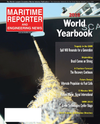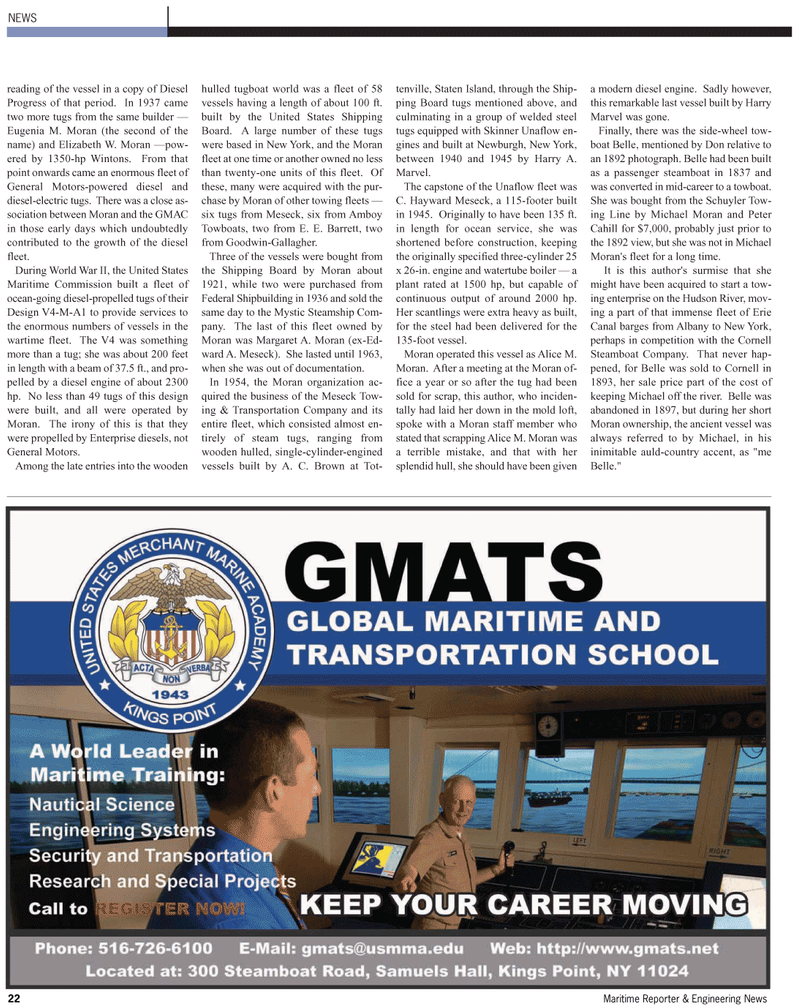
Page 22: of Maritime Reporter Magazine (June 2, 2010)
Read this page in Pdf, Flash or Html5 edition of June 2, 2010 Maritime Reporter Magazine
22 Maritime Reporter & Engineering News
NEWS reading of the vessel in a copy of Diesel
Progress of that period. In 1937 came two more tugs from the same builder —
Eugenia M. Moran (the second of the name) and Elizabeth W. Moran —pow- ered by 1350-hp Wintons. From that point onwards came an enormous fleet of
General Motors-powered diesel and diesel-electric tugs. There was a close as- sociation between Moran and the GMAC in those early days which undoubtedly contributed to the growth of the diesel fleet.
During World War II, the United States
Maritime Commission built a fleet of ocean-going diesel-propelled tugs of their
Design V4-M-A1 to provide services to the enormous numbers of vessels in the wartime fleet. The V4 was something more than a tug; she was about 200 feet in length with a beam of 37.5 ft., and pro- pelled by a diesel engine of about 2300 hp. No less than 49 tugs of this design were built, and all were operated by
Moran. The irony of this is that they were propelled by Enterprise diesels, not
General Motors.
Among the late entries into the wooden hulled tugboat world was a fleet of 58 vessels having a length of about 100 ft. built by the United States Shipping
Board. A large number of these tugs were based in New York, and the Moran fleet at one time or another owned no less than twenty-one units of this fleet. Of these, many were acquired with the pur- chase by Moran of other towing fleets — six tugs from Meseck, six from Amboy
Towboats, two from E. E. Barrett, two from Goodwin-Gallagher.
Three of the vessels were bought from the Shipping Board by Moran about 1921, while two were purchased from
Federal Shipbuilding in 1936 and sold the same day to the Mystic Steamship Com- pany. The last of this fleet owned by
Moran was Margaret A. Moran (ex-Ed- ward A. Meseck). She lasted until 1963, when she was out of documentation.
In 1954, the Moran organization ac- quired the business of the Meseck Tow- ing & Transportation Company and its entire fleet, which consisted almost en- tirely of steam tugs, ranging from wooden hulled, single-cylinder-engined vessels built by A. C. Brown at Tot- tenville, Staten Island, through the Ship- ping Board tugs mentioned above, and culminating in a group of welded steel tugs equipped with Skinner Unaflow en- gines and built at Newburgh, New York, between 1940 and 1945 by Harry A.
Marvel.
The capstone of the Unaflow fleet was
C. Hayward Meseck, a 115-footer built in 1945. Originally to have been 135 ft. in length for ocean service, she was shortened before construction, keeping the originally specified three-cylinder 25 x 26-in. engine and watertube boiler — a plant rated at 1500 hp, but capable of continuous output of around 2000 hp.
Her scantlings were extra heavy as built, for the steel had been delivered for the 135-foot vessel.
Moran operated this vessel as Alice M.
Moran. After a meeting at the Moran of- fice a year or so after the tug had been sold for scrap, this author, who inciden- tally had laid her down in the mold loft, spoke with a Moran staff member who stated that scrapping Alice M. Moran was a terrible mistake, and that with her splendid hull, she should have been given a modern diesel engine. Sadly however, this remarkable last vessel built by Harry
Marvel was gone.
Finally, there was the side-wheel tow- boat Belle, mentioned by Don relative to an 1892 photograph. Belle had been built as a passenger steamboat in 1837 and was converted in mid-career to a towboat.
She was bought from the Schuyler Tow- ing Line by Michael Moran and Peter
Cahill for $7,000, probably just prior to the 1892 view, but she was not in Michael
Moran's fleet for a long time.
It is this author's surmise that she might have been acquired to start a tow- ing enterprise on the Hudson River, mov- ing a part of that immense fleet of Erie
Canal barges from Albany to New York, perhaps in competition with the Cornell
Steamboat Company. That never hap- pened, for Belle was sold to Cornell in 1893, her sale price part of the cost of keeping Michael off the river. Belle was abandoned in 1897, but during her short
Moran ownership, the ancient vessel was always referred to by Michael, in his inimitable auld-country accent, as "me
Belle."

 21
21

 23
23
